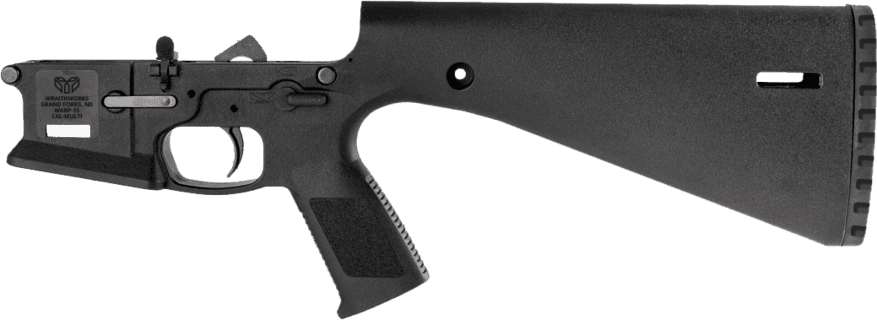Buying a lower can be an intimidating prospect – especially for shooters who are building their first AR. There are countless manufacturers offering lowers that range in quality from bargain bin to luxury, and it’s easy to be confused by all of the terminology. Luckily, we’ve put together this guide on AR-15 lowers that covers everything you’ll need to know to pick the perfect lower receiver for your budget and your shooting needs.
Manufacturing Processes
The majority of AR-15 lowers are manufactured from aluminum, but not all aluminum is created equal. The two types of alloy you will come across when shopping for lowers are 6061-T6 and 7075-T6. So what do those numbers actually mean? The important takeaway is that 7075-T6 aluminum boasts almost twice the tensile strength as 6061-T6, at the cost of being slightly more susceptible to corrosion. The difference in price is relatively minimal, and corrosion isn’t going to be a major concern unless you plan on having a bare metal lower, so generally speaking the peace of mind that comes with 7075-T6 is worth a few extra bucks. [Bear Creek Arsenal's AR-15 and AR-10 complete lowers are manufactured here in Sanford, NC from 7075-T6 aluminum and hard coat anodized for maximum durability.]
But the differences don’t end there – the manufacturing process used to construct each lower also has an impact on the cost, strength, and finish of the receiver.
Billet
As the name suggests, billet lower starts out as a solid billet, or block, of high-grade aluminum that is milled out by a CNC machine according to the final lower design. Billet lowers are kept to extremely tight tolerances and have a very fine finish, which makes them an attractive option for show guns or heavy customization – specialized engravings, roll marks, selector markings, and even modified mag wells are all as simple as plugging the design into the CNC machine. There are a few downsides, of course: billet lowers tend to be a bit heavier, and the extra labor required to build them generally translates into a bigger price tag. [Bear Creek Arsenal AR-10 billet aluminum lowers include a trigger guard that is integrated into the lower receiver and thus requires no pins or screws. The bolt catch is also held in with a set screw.]
Forged
Forged lowers are the most common option available, and for good reason – they are the most durable lower you’ll find thanks to the compressive forces of the forging process, and they tend to be marginally lighter and more budget-friendly than a billet lower. As with everything, there are trade-offs: tolerances aren’t always as tight, meaning that even though your rifle will function perfectly, you may not get the seamless fit between the upper and lower receiver that a billet lower can offer. Customization is also a bit more limited, so don’t expect much more than custom engraving. Still, if you’re looking for a lower that will get the job done every time with no fuss, a forged lower is hard to beat. [Our AR-15 multi-caliber complete lowers are manufactured from forged 7075-T6 aluminum and anodized for maximum durability.]

Cast
Though it’s being mentioned for the sake of completeness, it’s hard to recommend a cast lower these days. Made by melting down aluminum and pouring it into a mold before putting the finishing touches on it with a CNC machine, cast lowers used to be a very affordable option that were still sturdy enough to handle any conditions the average shooter is likely to encounter. But as the price of billet and forged lowers dropped over the years, the only advantage of cast lowers gradually disappeared, and most manufacturers stopped producing cast lowers altogether. Simply put, the other options are simply more durable and less prone to quality control issues in exchange for a negligible price increase.

Polymer
Of course, no discussion is complete without mentioning the new kid on the block – polymer lowers. Thought Colt actually experimented with polymer lowers in the late 1960s, the concept was shelved and seemed destined to be forgotten – until recently, when manufacturers decided that it might be worth giving it another try. After all, polymer is lighter, cheaper, and easier to work with than aluminum, and it’s strong enough to hold up to the forces that an AR-15’s lower receiver is exposed to. The problem is that there are a few points of failure where plastic just doesn’t hold up – particularly near the safety selector detent and the buffer tube. While innovations in polymer lower design have mostly solved these problems, it requires enough extra material that the main benefit of a polymer lower – the weight – is hardly noticeable.
The exception to this is what is known as a “monolithic polymer lower,” in which the receiver, stock, and grip are all made out of a single piece of polymer. Compared to a traditional aluminum lower with a separate stock and grip, a monolithic polymer lower can shave off an entire pound of weight, which is certainly substantial enough to be noteworthy. It does greatly diminish how modular and customizable your rifle will be, but if weight is your primary concern, it’s an option to consider.

Stripped vs. 80 Percent vs. Complete Lowers
The other major consideration when shopping for an AR-15 lower is how much work you want to put into assembling it. There are three options to choose from, and all have their place depending on your specific goals.
Stripped Lower
A stripped lower receiver is one that has been completely machined by the manufacturer, and it is considered a legal firearm under federal law, meaning the applicable paperwork and FFL transfer process will need to be completed. A stripped lower will be ready to use right away, assuming you’ve got a lower parts kit and trigger ready to go. Buying a stripped lower is a good choice if you have a specific build in mind – say you want to use a two-stage competition trigger, or a certain pistol grip that fits your hand better. It’s not as labor intensive as an 80% lower, but you can save a decent amount of money compared to buying a complete lower, especially if you’re swapping out most of the components, making it a solid middle-of-the-road option suitable for even a first-time AR-15 builder.
80% Lower
If you’re the DIY type, have the necessary tools, and want to customize your lower to your exact specifications, an 80% lower might be the choice for you. As the name implies, an 80 percent lower is one that has only been milled and drilled by the manufacturer to 80 percent completion, meaning it is not legally considered a firearm and therefore does not require the paperwork or FFL transfer process that other lowers do. You’ll need a good drill press, a specialized 80% jig, and ideally access to a milling machine, so it may not be the most practical choice for most shooters – but for those who are up to the challenge, buying an 80% lower gives you unrivaled control over the finished product, while saving you money on both the receiver and the FFL transfer fee. It’s not hard to see why 80% lowers are becoming increasingly popular choices for those with the tools to finish the job. [Because 80 lowers are non-FFL items, they can ship directly to your door, limiting the paperwork and time it takes to receive your product.]

Complete Lower
If you just want to put together an AR as quickly as possible and aren’t interested in the upgraded options offered by aftermarket triggers, grips, stocks, or magazine releases, a completed lower will get you shooting right out of the box with no assembly required. A complete lower can be an easy and economical way to put together an AR-15 if you don’t have plans to swap out of any of the parts and buy your lower from a reputable manufacturer with quality components.

Ambidextrous Lowers
One last option that is worth considering when building your AR-15 is an ambidextrous lower. Though it may seem strange to spend more money on a lower that can be used by both right and left-handed shooters, there is a case to be made for it if you plan on using the rifle for home defense or duty use and have room in your budget to accommodate the higher price tag. There’s a simple reason for this – in an emergency, life or death situation, there is always the possibility that your dominant shooting hand could be injured or otherwise occupied. It’s why elite military and law enforcement perform off-hand drills in training, and while being able to confidently manipulate your rifle with either hand is something that may never be necessary, it’s a factor to consider when building a rifle with those situations in mind.
Lower Receiver & Upper Receiver Compatibility
Most AR15 lowers are manufactured to Mil-Spec,the specifications of the US military.That means that mixing and matching ar lowers and uppers from various companies is relatively easy as they are built to the same specifications.
When it comes to the AR-10, things are a little more complicated. First, it’s worth noting that there isn’t actually a true “mil-spec” for this platform, since it was never widely adopted or given an official specification by the military. And unlike the AR-15, there was never a push towards industry standardization for AR-10 design.While this originally boiled down to a choice between the classic Armalite pattern or the first generation LR-308 pattern developed by DPMS Panther Arms, the budding popularity of the AR-10 platform in recent years has resulted in many other manufacturers entering the market with their own patterns, many of which are incompatible with each other.
Thus it is best to either stick to the same company for AR10 lowers and upper receivers, or verify the pattern used by each manufacturer. [Bear Creek Arsenal's AR15 lowers, AR15 uppers, and AR15 parts are built to Mil-Spec and AR10 lowers and AR10 Uppers are DPMS 1st Gen Low Profile pattern.]
Conclusion
[We hope this helped you learn more about AR lowers and decide which type would be best for you! Leave a comment about what you found interesting or anything you think we missed. Also, be sure to read our other articles about 300 Blackout and 5.56 vs 308.]





